Alfred Gilbert
Sir Alfred Gilbert RA (12 August 1854 – 4 November 1934) was an English sculptor. He was born in London and studied sculpture under Joseph Boehm, Matthew Noble, Édouard Lantéri and Pierre-Jules Cavelier. His first work of importance was The Kiss of Victory, followed by the trilogy of Perseus Arming, Icarus and Comedy and Tragedy.
Alfred Gilbert RA | |
|---|---|
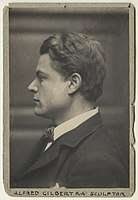 Portrait of sculptor Alfred Gilbert by Frederick Hollyer (1887) | |
| Born | 12 August 1854 London |
| Died | 4 November 1934 (aged 80) |
| Nationality | English |
| Education | Mercers' School, Aldenham School, Thomas J. Heatherley School of Art, Royal Academy Schools, École des Beaux-Arts |
| Occupation | Sculptor |
| Years active | 1878–1932 |
| Era | Victorian |
Notable work | Shaftesbury Memorial Fountain, Tomb of Prince Albert Victor, Queen Alexandra Memorial |
| Spouse(s) | Alice Jane Gilbert, Stéphanie Quaghebeur |
| Children | George, Mary, Francis, Alfredo and Charlotte Emily (later known as Caprina Fahey) |
| Parents |
|
Gilbert's most creative years were from the mid 1880s to the mid 1890s, when he created celebrated works such as a memorial for the Golden Jubilee of Queen Victoria and the Shaftesbury Memorial Fountain. As well as sculpture, he explored other techniques such as goldsmithing and damascening. He was made a member of the Royal Academy in 1892, yet his personal life was beginning to unravel since he took on too many commissions and entered into debt, whilst at the same time his wife's mental health deteriorated.
Gilbert received a royal commission for the tomb of Prince Albert Victor in 1892, but was unable to finish it and the complaints from other dissatisfied clients began to build up. By the mid 1900s, Gilbert had been forced to declare himself bankrupt and to resign from the Royal Academy. He moved to Bruges in disgrace and separated from his wife. He later remarried, entering a period when he created few artworks.
However, in the 1920s his career was rehabilitated with the help of journalist Isabel McAllister. He returned to England and finally completed the tomb of Prince Albert Victor, as well as taking on new commissions such as the Queen Alexandra Memorial. In 1932, Gilbert was reinstated as a member of the Royal Academy and was also knighted. He died in 1934, at the age of 80. Gilbert was a central inspiration for the New Sculpture movement and in the 21st-century is regarded as one of the foremost sculptors of the Victorian age.
Early life
Alfred Gilbert was born 12 August 1854 at 13 Berners Street, which was near Oxford Street in central London. He was the eldest child of Charlotte Cole and Alfred Gilbert, who were both musicians.[1] He first attended the Mercers' School, then switched to Aldenham School in Hertfordshire, where his father taught music.[2][1]
His father pushed Gilbert to become a surgeon, so he applied to the Royal College of Surgeons and was accepted in 1872.[3] He then went for a scholarship at Middlesex Hospital to work as a surgeon and was rejected, allowing him to pursue his true interest of sculpture. Studying first at the Thomas J. Heatherley School of Art in London from 1872 until 1873, afterwards he went to the Royal Academy Schools from 1873 until 1875.[1] Eager to learn, he also worked in the studios of Sir Joseph Boehm, Matthew Noble, and William Gibbs Rogers.[3] Gilbert was to credit Boehm and his assistant Édouard Lantéri as his true teachers.[1]
Gilbert later travelled to Paris to study at the École des Beaux-Arts under Pierre-Jules Cavelier. He had fallen in love with his first cousin, Alice Jane Gilbert, and they were forced to elope. In Paris they lived on rue Humboldt.[1] Gilbert moved to Italy in 1878 and returned to England in 1884.[4]
Career
Early works
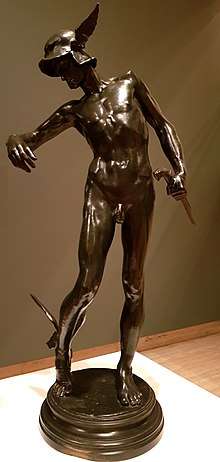
Gilbert's first work of importance was The Kiss of Victory (1878–1881), which depicted a Roman soldier dying in the arms of Victory. He moved with his family to Rome in order to create the sculpture in marble, attracted by famed sculptors of the Renaissance such as Cellini, Donatello, Giambologna and Verrocchio.[1] It was exhibited at the Royal Academy in 1882.[5]
Perseus Arming (1882) was inspired by a visit to Florence and influenced by Donatello's David and Cellini's Perseus with the Head of Medusa. It was Gilbert's first statue made in bronze.[1] The work was acclaimed and led Lord Leighton to commission Icarus (1884), which was exhibited at the Royal Academy in 1884, along with Study of a Head (1882–3). Gilbert next created The Enchanted Chair (c. 1885), which was ultimately broken by the sculptor's own hand.[3]
Gilbert later stated to Joseph Hatton that the bronze statues Perseus Arming, Icarus and Comedy and Tragedy (1891–2) formed a trilogy which referred back to his own life. Perseus Arming had a huge impact on a new generation of artists, since the method of casting (lost wax) was new to the English milieu and its size of 29 inches was innovative, being between the usual categories. Perseus Arming was to become a particular inspiration for the New Sculpture movement.[1]
Creative period
Having returned to England, Gilbert's next work was again an innovation in terms of size. The Fawcett memorial (1885–7) featured a bust of politician Henry Fawcett above seven small detailed figures of around fifteen inches, which individually represented Fawcett's virtues.[1] Gilbert then produced a memorial commissioned in 1887 for the Golden Jubilee of Queen Victoria, which was placed in the Great Hall at Winchester Castle. He was entering his most creative period, and diversified into goldsmithing and damascening. He made an epergne (1887–1890) given to Queen Victoria for her jubilee by army officers and a chain for the mayor of Preston (1888–1892).[1] He also created spoons, cups, dishes and jewellery.[6] Writing in British sculpture and sculptors of today (published in 1901), Marion Spielmann wrote that "his taste is so pure, his genius so exquisitely right, that he may give full rein to his fancy without danger where another man would run riot and come to grief".[7]
Gilbert's next sculptural work of note was the Shaftesbury Memorial Fountain. Anthony Ashley-Cooper, 7th Earl of Shaftesbury, a philanthtropist, had died in late 1885 and it was swiftly decided to commemorate his life with two monuments, one at Westminster Abbey and another at Cambridge Circus, at the beginning of Shaftesbury Avenue (which was concurrently named after him).[8] The memorial was commissioned in 1886 and officially opened at Piccadilly Circus in London in 1893. Gilbert had accepted the commission with assurances that he would be given used gunmetal to melt down and reuse, however the government did not supply him with it. Since he had already produced the casts, he was forced to buy copper to use instead, which meant that he took a substantial financial hit, since the fountain should have cost £3,000 (equivalent to about £329,207 in 2019) but actually the figure was £7,000 (equivalent to about £768,150 in 2019), and Gilbert was forced to pay the difference.[1] It was only because he had been experimenting with different techniques that he was able to cast aluminium, a then new material which he used to create the statue of Anteros which topped the sculpture.[1] It is commonly believed that the statue represents Eros, but Anteros is actually his brother, the avenger of unrequited love.[9] The fountain is now well-regarded and seen as a national treasure, but at the time it was controversial, with opinions on its value mixed. The mainstream media criticised the design of the fountain which led to passing flower girls being drenched in water and hooliganism meant it needed to be guarded for a year. Eight drinking cups on chains had been provided for pedestrians to quench their thirst and Gilbert stated that just one day after the opening, only two cups remained. He referred to the "painful experience of witnessing the utter failure of my intention and design".[8]
In this period, Gilbert made statues of Donald Mackay, 11th Lord Reay, and prison reformer John Howard. He made memorials of the Duke of Clarence and of Lord Arthur Russell, and a memorial font for the son of the 4th Marquess of Bath.[3] He produced busts of Cyril Flower, John R. Clayton (later broken up by the artist), George Frederic Watts, Henry Tate, George Birdwood, Richard Owen and George Grove. He also designed the statue of David Davies of Llandinam in front of the Barry Docks offices.[3]
Gilbert was made a member of the Royal Academy in 1892.[10] He received many other honours, such as Royal Victorian Order of the fourth class (1897).[1] He became a member of the International Society of Sculptors, Painters and Gravers and in 1889 he won the Grand Prix at the Paris International Exhibition.[11][3] Unfortunately, as his fame grew, his private life began to fall apart. When Boehm died in 1890, Gilbert had become England's best known living sculptor. He was a member of the Athenaeum and Garrick clubs in London and was a man about town in his trademark dress of cape, sombrero and walking-stick.[1] His friends included the artists Edward Burne-Jones, Frederic Leighton, George Frederic Watts and James Abbott McNeill Whistler.[12][1] Befriending Princess Louise had brought him into high society and he built a large house for his family with an attached studio in 16 Maida Vale, in north London, yet Gilbert's generous and extravagant lifestyle was leading him into debt. Moreover, his wife Alice was not at ease in London society and preferred to stay in a rented house in Gomshall, Surrey; soon after the unveiling of the Shaftesbury Memorial Fountain, Alice had a breakdown and was committed to an asylum.[1]
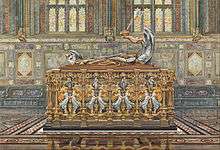
In 1892, Gilbert was asked by the Prince (later Edward VII) and Princess of Wales (Alexandra of Denmark) to build the tomb for their recently deceased eldest son Prince Albert Victor in St George's Chapel, Windsor.[1] Prince Albert Victor had been heir to the throne and died of pneumonia resulting from contracting influenza during the 1889–1890 flu pandemic.[13] The tomb has been described by a critic as "the finest single example of late 19th-century sculpture in the British Isles".[14] A recumbent effigy of the prince wearing a Hussar uniform lies above the tomb. Kneeling over him is an angel, holding a heavenly crown. The tomb is surrounded by an elaborate railing, with figures of saints.[15] The perfectionist Gilbert spent too much time and money on the commission. Five of the saint figures were only completed with "a greater roughness and pittedness of texture" after his return to Britain in the 1920s.[14]
Disgrace
By 1898, Gilbert was in debt and the number of complaints from clients asking for completed works was increasing. Instead of finishing the tomb for Prince Albert Victor, which only had seven of the twelve saints around it, Gilbert took another royal commission, namely building the mortuary chapel for Prince Henry of Battenberg. Ultimately, Gilbert was forced to file for bankruptcy in 1901. He sent his family before him to Bruges in Belgium and stayed behind to pack up his studio, destroying many casts in the process.[1]
The Prince of Wales offered Gilbert a studio at Windsor Castle where he could complete his work but Gilbert only compounded his problems in 1903 by asking the royal family for permission to publish photographs of the work in progress and then proceeding to do so even though he was clearly asked not to. To make things even worse, the photographs depicted the ivory and bronze statues which had been originally attached to the tomb and then sold off by Gilbert in 1899. They had been replaced by the bronze casts which still sit on the tomb, but the prince had paid for the originals and was angered. He broke off all communication with Gilbert.[1]
By the mid 1900s, Gilbert was in serious problems. In 1904, he had separated from his wife. Dissatisfied clients had spoken to a gossip magazine called Truth which released two well-circulated articles in 1906. The Duke of Rutland was driven to complain to the president of the Royal Academy (Edward Poynter) about an incompleted order in 1908 and Gilbert was given the choice either to resign or to be expelled from the Academy.[1] Poynter commented "We have all come to the regretful conclusion that he is hopelessly incorrigible".[16] Gilbert decided to quit, resigning his professorship and his award of the Victorian order in addition. Things deteriorated further when he had an affair with a client called Eliza Macloghlin and she demanded the urn she had commissioned. Upon not receiving it, she threw stones at the windows of his studio in Bruges and wrote a demented letter to King Edward VII. Unfortunately her handwriting was similar to Gilbert's and it was believed he had written the screed, making his situation even more hopeless. When his son Francis went to see Gilbert in 1908, he found him hungry and lacking adequate clothes. In this period, Gilbert completed few works.[1]
Rehabilitation
.jpg)
During World War I, Gilbert remained in Bruges.[1] Three illustrations for Arthur Conan Doyle's short story "His Last Bow. The War Service of Sherlock Holmes" were published in The Strand Magazine in 1917 and in 1921 three more for "The Adventure of the Mazarin Stone".[17][18] He married his housekeeper Stéphanie Quaghebeur on 1 March 1918 and they moved to Rome together in 1924.[1] In the early 1920s, Gilbert had been largely forgotten about in England and was assumed to have died, since he had fled from England to Europe decades before. However, he was still receiving a civil list pension and when the journalist Isabel McAllister took an interest in him, she was able to find him easily. She decided to write his biography and campaigned for his re-acceptance in English high society. Writing to King George V and various dignitaries, she promoted Gilbert's talents, arguing it was time for him to finish the tomb of Prince Albert Victor and also that he was the perfect person to take the commission to create a memorial to Alexandra of Denmark, who had died in 1925. The King was glad to hear of his old acquaintance and Lady Helena Gleichen became Gilbert's promoter, offering that he could use her studio at St James Palace if funds could be raised to bring him from Italy.[19]
Gilbert returned to England on 26 July 1926 and his mental state concerned Lady Gleichen, since she said he was "broken with nerves, and agitation".[19] Fortunately friends rallied around him and Gilbert settled down. The King provided a stipend and he used studio at St James's Palace and later Kensington Palace. By March 1928, he had finally finished the five statues which completed the tomb of Prince Albert Victor (who had been George's older brother).[19][1] Already in late 1926, Gilbert had received a new commission, to make the Queen Alexandra Memorial. It captured his imagination since he saw this major public artwork as his swan song. Further, Alexandra had been a firm friend of his, supporting him financially even when he failed to complete the tomb for her eldest son. After he had fled England, she had commissioned a portrait from him in 1903 (it is unknown if it was made) and in 1904, she sent him £100 (equivalent to about £10,854 in 2019).[19]
The monument commemorated Alexandra, who had previously been King Edward VII's wife, until his death in 1910. The sculpted fountain blended art nouveau and gothic styles, and was built into the wall of Marlborough House. It was officially unveiled on 8 June 1932, which was announced as Alexandra Rose Day . It depicts three figures representing Faith, Hope, and Charity who are helping a maiden move across the stream of life. Gilbert was knighted the day afterwards and was also readmitted into the Royal Academy. His return to favour was complete.[1]
Personal life
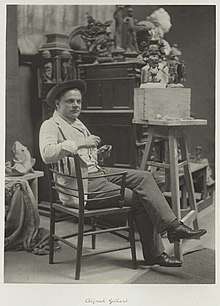
On 3 January 1876, Gilbert eloped to Paris with his first cousin, Alice Jane Gilbert (1847–1916), and they were married the same day. They had five children, namely George (born 1876), Mary (born 1877), Francis (born 1879), Alfredo (born 1880) and Charlotte Emily (born 1881).[1] Charlotte was to become a notable suffragette under the name Caprina Fahey.[20]
Gilbert's wife Alice had a breakdown soon after the official opening of the Shaftesbury Memorial Fountain in 1893 and she spent some time in an asylum. The family left England again in 1901 and settled in Bruges. The marriage broke down in 1904. Alice again became a patient in a mental hospital and died in 1916.[21] Gilbert remarried in 1918 with his housekeeper Stéphanie Quaghebeur.
Death and legacy
Gilbert died on 4 November 1934 at Cromwell Nursing Home in London. He was then cremated. At the time of his death, Gilbert was one of the most well-known figures in English society and there were plans to make a film about him.[1] He was then disregarded for decades, until critic Richard Dorment published a biography of Gilbert in 1985, which was followed by a retrospective at the Royal Academy of Arts in 1986. Gilbert is now regarded as one of the foremost sculptors of the Victorian age.[1]
In 2017, a bust of Queen Victoria by Gilbert worth £1.2 million was subject to an export ban, having been sold at Sotheby's to a museum based in New York. Eventually, the Fitzwilliam Museum raised the funds to pay £1.01 million to keep the bust in the UK. The work of art was deemed to meet all three of the Waverley Criteria, namely that it was important artistically, it was part of British history and it was important to the study of art. The sum was raised through donations and a £267,600 grant from the National Heritage Memorial Fund (NHMF).[22][23]
Gallery
.png) Mother Teaching Child (1881)
Mother Teaching Child (1881)_-_Icarus_(1882-4)%2C_front_left%2C_Tate_Britain%2C_Dec_2012_(8560256773).png) Icarus (1882-4)
Icarus (1882-4)_-_The_Enchanted_Chair_(c1885)_(22696372226).png) The Enchanted Chair (c. 1885)
The Enchanted Chair (c. 1885)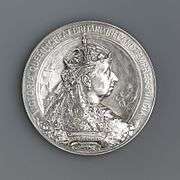 Silver commemorative coin (1887)
Silver commemorative coin (1887)- Comedy and Tragedy (1891)
 Bust of Nina Cust (1894)
Bust of Nina Cust (1894)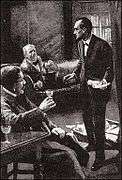 Illustration for Arthur Conan Doyle's "His Last Bow. The War Service of Sherlock Holmes" (1917)
Illustration for Arthur Conan Doyle's "His Last Bow. The War Service of Sherlock Holmes" (1917)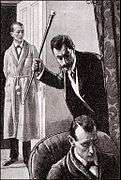 Illustration for Arthur Conan Doyle's "The Adventure of the Mazarin Stone" (1921)
Illustration for Arthur Conan Doyle's "The Adventure of the Mazarin Stone" (1921)
Selected works
- Shaftesbury Memorial Fountain, Piccadilly Circus, London
- The tomb of Albert Victor, Duke of Clarence in St. George's Chapel, Windsor
- The Queen Alexandra Memorial, Marlborough Gate, London
References
- "Gilbert, Sir Alfred". Oxford Dictionary of National Biography (online ed.). Oxford University Press. doi:10.1093/ref:odnb/33398. (Subscription or UK public library membership required.)
- Edwardian Architecture: A Biographical Dictionary, A. Stuart Gray, University of Iowa Press, p. 189
-

- "Sir Alfred Gilbert RA (1854 - 1934)". Royal Academy of Arts. Archived from the original on 16 June 2020. Retrieved 17 June 2020.
-

- Read, Benedict (1986). "Alfred Gilbert. London, Royal Academy". The Burlington Magazine. 128 (999): 446–449. ISSN 0007-6287. Retrieved 17 June 2020.
- Spielmann, M. H. (Marion Harry) (1901). British sculpture and sculptors of today. London, New York: Cassell. p. 85. Archived from the original on 26 April 2016. Retrieved 17 June 2020.
- Sheppard, F.H.W. (1963). "Survey of London". British History Online. London: London County Council. 31 & 32: 101–110. Archived from the original on 7 August 2018. Retrieved 17 June 2020.
- "Sculptures by Sir Alfred Gilbert". Bowman Sculpture. Archived from the original on 16 June 2020. Retrieved 17 June 2020.
- "Archived copy". Archived from the original on 16 June 2020. Retrieved 17 June 2020.CS1 maint: archived copy as title (link)
- "The International Society of Sculptors, Painters and Gravers". Mapping the Practice and Profession of Sculpture in Britain and Ireland 1851–1951. Glasgow University. Archived from the original on 1 July 2013. Retrieved 31 May 2013.
- "Alfred Gilbert, 1854-1934". Centre for Whistler Studies. University of Glasgow. Archived from the original on 5 November 2005. Retrieved 18 June 2020.
- "Albert Victor, Prince, duke of Clarence and Avondale". Oxford Dictionary of National Biography (online ed.). Oxford University Press. doi:10.1093/ref:odnb/275. (Subscription or UK public library membership required.)
- Roskill, Mark (1968). "Alfred Gilbert's Monument to the Duke of Clarence: A Study in the Sources of Later Victorian Sculpture." The Burlington Magazine. Vol. 110 Issue 789, pp. 699–704.
- St George's Chapel, Windsor Castle (2008). "Albert Memorial Chapel" Archived 10 June 2008 at the Wayback Machine. Accessed 28 March 2008.
- Jeffries, Richard (1986). "Review of Alfred Gilbert". Journal of the Royal Society of Arts. 134 (5358): 414–415. ISSN 0035-9114. JSTOR 41374150.
- Wexler, Bruce (2020). The Mysterious World of Sherlock Holmes (ebook ed.). Simon and Schuster. ISBN 9781510749610. Retrieved 17 June 2020.
- Cawthorne, Nigel (2011). A brief history of Sherlock Holmes (eBook ed.). Hachette UK. p. 160. ISBN 9781780331560. Retrieved 17 June 2020.
- Dorment, Richard (1980). "Alfred Gilbert's Memorial to Queen Alexandra". The Burlington Magazine. 122 (922): 47–54. ISSN 0007-6287. Retrieved 17 June 2020.
- Briscoe, Kim. "Call for public's help to piece together life of Norfolk suffragette Caprina Fahey". Eastern Daily Press. Archived from the original on 3 October 2019. Retrieved 12 October 2019.
- "Gilbert, Alfred". Who's Who: 946. 1919. Archived from the original on 8 December 2019. Retrieved 9 August 2017.
- "Minister bars the export of Queen's head". The Times. 9 September 2017. Archived from the original on 9 September 2017. Retrieved 16 June 2020.
- Capon, Alex (21 June 2018). "Fitzwilliam Museum raises £1m to secure Queen Victoria sculpture". www.antiquestradegazette.com. Archived from the original on 16 June 2020. Retrieved 16 June 2020.
Further reading
- Beattie, Susan. The New Sculpture. New Haven: Yale University Press, 1983.
- Dorment, Richard. Alfred Gilbert. New Haven: Yale University Press, 1985.
- Dorment, Richard, et al. Alfred Gilbert: Sculptor and Goldsmith. London: Royal Academy of Arts, 1986.
- Edwards, Jason. Alfred Gilbert's Aestheticism: Gilbert Amongst Whistler, Pater, Wilde, and Burne-Jones Aldershot: Ashgate, 2006.
- Getsy, David. Body Doubles: Sculpture in Britain, 1877–1905. New Haven and London: Yale University Press, 2004.
- Read, Benedict. Victorian Sculpture. New Haven: Yale University Press, 1982.
External links

- "Works by Alfred Gilbert on Art UK". artuk.org. Retrieved 17 June 2020.
- "Works by Alfred Gilbert at Tate". Tate. Retrieved 17 June 2020.
- "Works by Alfred Gilbert at V&A". Victoria and Albert Museum. Retrieved 17 June 2020.